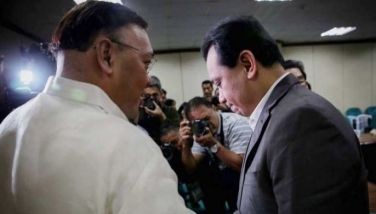Isko Moreno wants skyways, 'more space' for cars in urban areas
MANILA, Philippines — Manila City Mayor Isko Moreno, a presidential aspirant, wants more road space to address the longstanding problem of traffic on the nation's thoroughfares, he said Monday.
Speaking at the presentation of his 10-Point Economic Action Agenda on Monday morning, Moreno proposed the construction of "tourism highways" to "develop tourism circuits."
For his infrastructure platform, Moreno presented his agenda of "roads, electricity, water, and internet for all," saying he would "improve physical connectivity [by constructing] trimodal transport systems" in Luzon, Visayas, and Mindanao.
Asked how he plans to address the problem of traffic, though, the Aksyon Demokratiko standard-bearer said: "As a leader, if given a chance, I'll confront it by creating more space for our vehicular traffic. Space occupied by matter [means] lesser space."
Per data from the Japan International Cooperation Agency, 88% or almost nine out of ten households in Metro Manila do not own private vehicles and have to rely on public transportation.
"Trains cost money and are more expensive to build. Private sectors, whether in the Philippines or outside the country, are welcome if they come in...but we cannot wait and wait for investors to come in," Moreno said.
According to the Move as One Coalition, 99% of the P2.8-trillion road-based infrastructure budget went to road construction, widening, and maintenance from 2020 to 2021. Only 1%–or P40 billion–of the road-based infrastructure budget went to road-based public transportation.
"We know for a fact that the population will grow and hopefully the economy will grow and more people will acquire vehicles...we need more space for a highly urbanized metropolis like Metro Manila, the Visayas, and maybe Mindanao."
Do more roads actually mean less traffic?
Urban planners and transport economists have long contested the idea that building or widening roads can lessen traffic, pointing to the concept of induced demand.
In economics, induced demand refers to the situation where more of a good is consumed as its supply increases. In road infrastructure, induced demand happens when increased roadway capacity encourages more people to drive, and consequently failing to improve congestion—sometimes even worsening it.
This implies that new roads essentially serve to create more traffic instead of lessening it.
"Opening more roads leads to induced demand, meaning traffic will still increase no matter how many roads we build or open. If we want to lessen traffic congestion, we have to lessen car-dependency and improve other modes like public transport and active transport," commuter group AltMobility PH said in an earlier Philstar.com story.
READ: Expert warns of impending public transport crisis | Despite inadequate transportation, MMDA says commuters 'forgot' quarantine rules at GCQ's onset
Pre-coronavirus, labor and transport groups tagged the country's traffic situation as a mass transportation crisis, with long lines and technical malfunctions being commonplace in the daily lives of Filipino commuters.
According to a 2019 survey by the Japan International Cooperation Agency, "daily economic losses because of congestion in Metro Manila are estimated at P2.1 billion, which could rise to P3.3 billion a day by 2035 if no action is taken."
Moreno didn't see it that way, however. "What if there is no [investor]? Then the people of Metro Manila will suffer," he said. "I think the immediate and doable [solution] is to create more skyways vertically and create more space."
Public transport not at the center of infra plans
Moreno in his presentation vowed to "accelerate infrastructure building [to] strengthen physical, economic, and digital linkages [and] prioritize equitable growth."
He went as far as promising "100% access to safe water and sanitation by 2026" and "zero water pollution by 2028."
He said that electricity in the Philippines was "unreliable" and the "most expensive in Southeast Asia" while up to 58% of households "do not have water supply piped directly to their dwellings."
"Everyone should have access to 1 megabyte per second internet," he also said as he promised to "improve access to information and communications technology with sub-regional, regional, and metro centers.
Moreno's approach to public transport mirrors that of the Duterte administration's flagship Build, Build, Build campaign, under which projects, such as Skyway Stage 3 and the BGC-Ortigas Bridge, were heavily touted to alleviate commuter woes.
During the 2016 presidential election campaign, Duterte promised that he would solve the traffic problem on EDSA in three to six months. He later on vowed to cut down travel time from Cubao to Makati to five minutes by December of 2019, both of which he has yet to make good on.
- Latest
- Trending
































